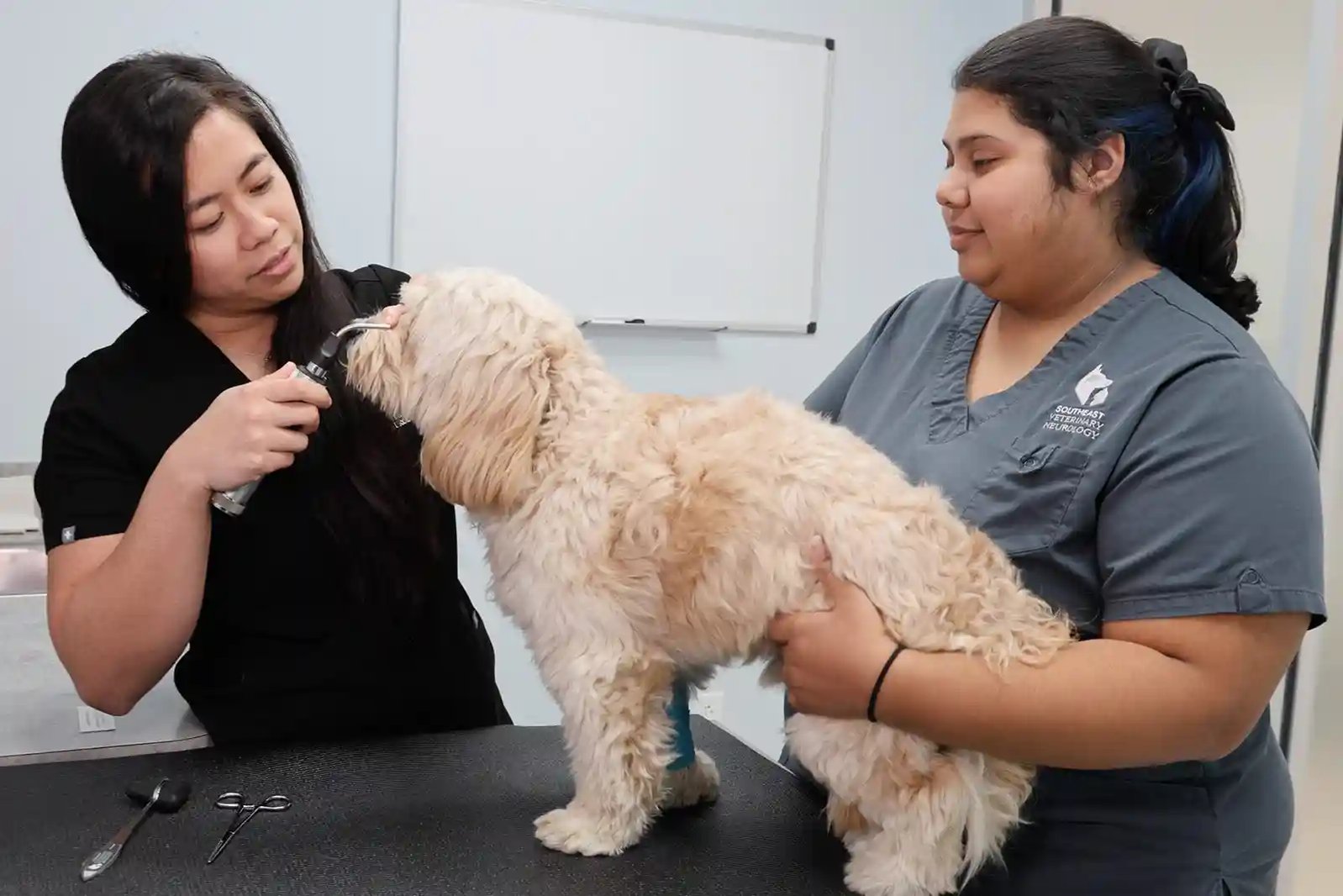ANNPE: What It Is and How to Care for Your Dog
ANNPE stands for acute non-compressive nucleus pulposus extrusion (say that five times fast!) and is a form of intervertebral disc disease in dogs. ANNPE is a neurological emergency that suddenly affects the spinal cord and your dog’s ability to walk.

Before we dive all the way into ANNPE, let’s talk a little bit about the spinal cord and intervertebral disc disease in dogs.
What is Intervertebral Disc Disease (IVDD) in Dogs?
We can’t describe ANNPE or intervertebral disc disease without talking about the spinal cord. The spinal cord is a long bundle of nerve tissue that carries messages back and forth between the brain and the body. This important communication highway is protected by the vertebral column.
The vertebral column is made up of small bones, called vertebrae, that are connected by intervertebral discs. Intervertebral discs allow the spine to bend and absorb impact. They are made up of an outer fibrous ring, called the annulus fibrosus, and an inner jelly-like filling, known as the nucleus pulposus.
Intervertebral disc disease (IVDD) develops in dogs when an intervertebral disc protrudes or ruptures. IVDD is the most common spinal cord issue in dogs and is often referred to as a slipped disc, herniated disc, ruptured disc, bulging disc, or even a pinched nerve.
Many years ago, IVDD in dogs was first classified into two types, both resulting from disc degeneration and ultimately compressing the spinal cord:
- Acute, or Hansen Type I intervertebral disc extrusion
- Chronic, or Hansen Type II intervertebral disc protrusion
In more recent years, advances in veterinary diagnostic techniques, like MRI, have led to the identification of other forms of IVDD in dogs, such as an acute non-compressive nucleus pulposus extrusion, or ANNPE.

What Distinguishes ANNPE from Other Forms of IVDD in Dogs?
Unlike Hansen Types I and II, ANNPE does not result from disc degeneration, but from excessive force applied to a normal, healthy intervertebral disc. High-impact exercise or a fall can tear the outer annulus fibrosus, which can cause a small amount of the inner nucleus pulposus to shoot out of the disc and strike the spinal cord. Although this will not compress the spinal cord, it can cause an injury in the form of bruising, swelling, or bleeding.
The main differences between an acute non-compressive nucleus pulposus extrusion and other forms of intervertebral disc disease in dogs are:
- Only a small amount of disc material is involved
- The disc material is healthy and hydrated
- The spinal cord is not compressed
What are the Symptoms of ANNPE in Dogs?
ANNPE is most common in young, active, medium to large dogs. It can occur in any breed, but it often occurs in working, sporting, or otherwise high-drive dogs, like border collies.
Signs of an acute non-compressive nucleus pulposus extrusion in dogs include:
- Sudden pain during activity that can make your dog cry out
- Sudden lameness after activity, often on one side of the body
- Pain improves in minutes to hours
- Symptoms do not progress

How is ANNPE Diagnosed in Dogs?
All forms of intervertebral disc disease in dogs require advanced imaging for definitive diagnosis. MRI is considered the gold standard, as it can distinguish between compression, obstruction, contusion, and a tumor. MRI can also help predict prognosis, based on the size of the affected area and the severity of the damage.
MRI criteria for diagnosing an acute non-compressive nucleus pulposus extrusion in dogs are:
- Hyperintense lesion above the disc
- Reduced volume of a disc’s nucleus pulposus
- Small volume extradural material above the disc
- Narrowing of the disc space
- No spinal cord compression

How is ANNPE in Dogs treated, and What is the Prognosis?
ANNPE in dogs is typically treated conservatively with nursing care and physical rehabilitation. Restricting physical activity may be necessary for several weeks to allow both the spinal cord and the tear in the annulus fibrosus to heal. Since there is no compression to relieve, surgery is not helpful, and no medications have been shown to speed up recovery.
With enough time and proper care, the contusion will subside. Most dogs will improve within a few days and completely recover within a few weeks. Prognosis is excellent for the vast majority of patients with ANNPE.
Nursing care for an acute non-compressive nucleus pulposus extrusion in dogs may consist of:
- Crate rest
- Providing clean, soft, padded bedding
- Changing your dog’s position to avoid pressure sores
- Providing easy access to food and water
Light physical rehabilitation is also of benefit to avoid joint stiffness, muscle weakness, or atrophy.
Why is ANNPE in Dogs a Neurological Emergency?
Although all forms of intervertebral disc disease have similarities, they have differing treatment protocols and prognoses. For example, ANNPE in dogs has a good prognosis without surgery, whereas a more traditional intervertebral disc extrusion can have a poor prognosis without immediate surgery. Therefore, it is critical to achieve an accurate diagnosis in order to put your dog on the right path to recovery. If your dog suddenly becomes unable to walk, please contact a veterinary neurologist right away.
Southeast Veterinary Neurology is Your ANNPE Expert
With hospitals in Miami, Boynton Beach, Jupiter, Virginia Beach, and growing, Southeast Veterinary Neurology is your ANNPE expert. Contact us right away to examine your dog for an acute non-compressive nucleus pulposus extrusion.